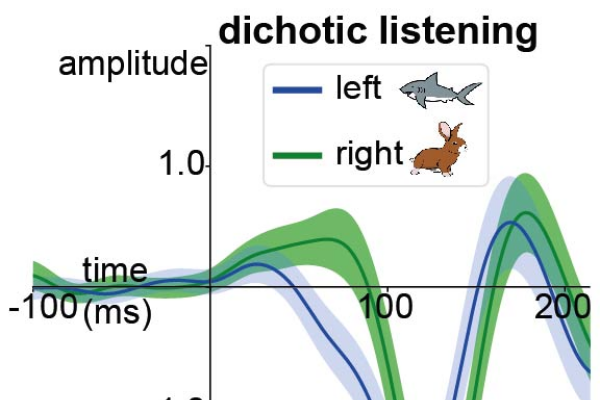2017-09-23

When the two hemispheres receive different sensory input, one might think of a race in which the faster hemisphere dominates our perception.
This can be demonstrated with the so-called “dichotic listening task”. Here, two different vowels are presented simultaneously; one to the left ear that reports to the right hemisphere and one to the right ear, which communicates to the left hemisphere. However, since the left hemisphere is specialized in analyzing vowels, this task is more like a swimming contest between a shark (the left hemisphere) and a rabbit (right hemisphere). Hence, the speed difference between the hemispheres is in favor of the left one.
By using the dichotic listening task in an EEG setting, we measured this hemispheric timing difference. Furthermore, by using MRI techniques, we found that the timing difference is smaller in participants with a better microstructure in the posterior part of the corpus callosum, a white matter commissure that is often called the bridge between the two hemispheres.
Hence, in our metaphor, this bridge seems to help the rabbit across the water, thus equalizing its chances in the swimming competition against the shark.

When the two hemispheres receive different sensory input, one might think of a race in which the faster hemisphere dominates our perception.
This can be demonstrated with the so-called “dichotic listening task”. Here, two different vowels are presented simultaneously; one to the left ear that reports to the right hemisphere and one to the right ear, which communicates to the left hemisphere. However, since the left hemisphere is specialized in analyzing vowels, this task is more like a swimming contest between a shark (the left hemisphere) and a rabbit (right hemisphere). Hence, the speed difference between the hemispheres is in favor of the left one.
By using the dichotic listening task in an EEG setting, we measured this hemispheric timing difference. Furthermore, by using MRI techniques, we found that the timing difference is smaller in participants with a better microstructure in the posterior part of the corpus callosum, a white matter commissure that is often called the bridge between the two hemispheres.
Hence, in our metaphor, this bridge seems to help the rabbit across the water, thus equalizing its chances in the swimming competition against the shark.